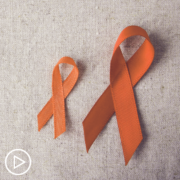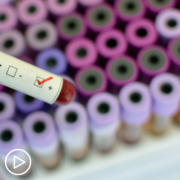Challenges in Treating TP53-Mutated AML, Hope on the Horizon
Challenges in Treating TP53-Mutated AML, Hope on the Horizon from Patient Empowerment Network on Vimeo.
TP53-mutated acute myeloid leukemia (AML) treatment has some challenges. Dr. Naval Daver from the University of Texas MD Anderson Cancer Center shares his perspective. Learn about promising treatments on the horizon for this AML subgroup.
[ACT]IVATION TIP from Dr. Daver: “The TP53 mutation remains the most difficult subset of acute myeloid leukemia, there is hope on the horizon with new treatments such as CD47 antibodies and targeted therapies like APR that are being looked at, and also a strong consideration for allogeneic transplant in TP53, because this seems to be the only modality associated with a good chance of cure after achieving remission with one of the frontline therapies.”
Download Resource Guide en español
Related Resources:

|

|

|
Transcript:
Art:
Dr. Daver, what have we learned about TP53-mutated AML? And what is the takeaway for these patients?
Dr. Naval Daver:
TP53-mutated AML remains the most difficult molecular subset of all acute myeloid leukemia. Patients who have this mutation, unfortunately, do not respond well to any of the established standard care therapies, including intensive chemotherapy, the HMA alone, such as azacitidine (Onureg or Vidaza), decitabine (Dacogen) alone, or even HMA venetoclax (Venclexta) with all of these, we do see responses, especially with HMA venetoclax or intensive chemotherapy, we can see 15 to 55 percent remission rate, but the remission, very short lived, early relapses and the median overall survival across all of these currently available standards of cares are between six to 10 months.
So there has been an intense effort in the last six, seven years to develop TP53-directed therapies or therapies that will work regardless of TP53 mutation, and there are two drugs this time that are very promising and being evaluated as ongoing Phase II and Phase III studies.
One of them is an immunotherapy drug called magrolimab which seems to have very similar activity and probability with good response rates in TP53-mutated AML. This has been completed in a single arm phase 1B study in front line TP53-mutated AML where we saw close to 50 percent CR, CRI complete permission rates. And median survival was above 11 months in older unfit TP53, which is better than any survival we have seen in the past in this population.
The other study was with the oral care targeted therapy towards TP53, called APR, and this therapy was specifically designed to target the TP53 mutation, and this is being evaluated in the frontline setting in combination with a society in venetoclax. We hope that these regimens are these novel therapies, one or both of them will be able to at least incrementally improve their current outcomes in TP53.
The other area where we have really been doing a lot of research, and I think the data is suggesting, is that allogeneic transplant may work for separate, and we are routinely considering transplant in these patients in the frontline setting, once they are able to achieve remission.
My activation tip is the TP53 mutation remains the most difficult subset of acute myeloid leukemia, there is hope on the horizon with new treatments such as CD47 antibodies and targeted therapies like APR that are being looked at, and also a strong consideration for allogeneic transplant in TP53, because this seems to be the only modality associated with a good chance of cure after achieving remission with one of the frontline therapies.



